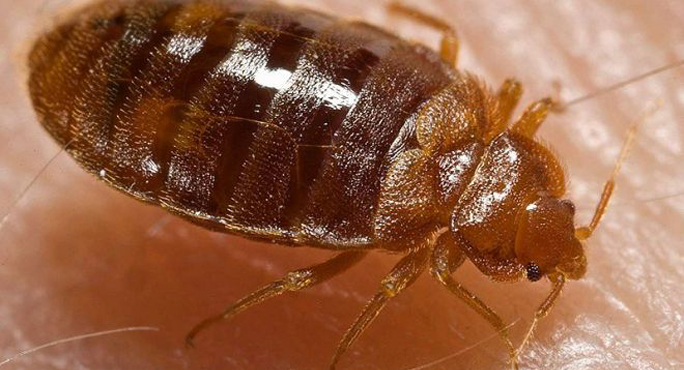
As more hotels get outed in the news for bed bug infestations, the public has become more aware of the problems that these creatures create. While the term “bed bug” may give the impression of a sleepy, relaxed little creature that somehow winds up in the sheets, the reality is way more alarming.
Flat, oval-shaped and reddish brown, bed bugs (Cimex lectularius) are parasites that feed on human blood. They resemble small roaches with horizontal lines on their backs. Though not exclusively nocturnal, bed bugs are mostly active at night. They prefer to live in beds and other places where people sleep, so they can be close to their source of nutrition: Fresh human blood. Because they like beds, they are known as “nest parasites.” However, bed bugs can also be found in couches, chairs, drapes, curtains, in drawers, inside appliances, and in tiny cracks in living spaces. As thin as a credit card, bed bugs can hide in very narrow spaces.
Bed bugs bite, leaving small bite marks which are typically red. Sometimes the bites bleed. Occasionally bed bugs will leave several bites in a row on skin. In many cases, bed bug bites cause itching and nothing more. Sometimes the bites cause insomnia and anxiety, according to the Centers for Disease Control. In some cases these bites can cause allergic reactions, including rashes and infections of the skin and lymph glands. In the most serious of cases, bed bug bites can induce anaphylaxis, a rapid, whole-body allergic reaction characterized by abdominal pain, difficulty breathing, anxiety, swelling, chest and throat problems, and unconsciousness. Anaphylaxis is no joke, often requiring a dose of epinephrine (adrenalin) to save the patient.
Bed bugs feast well in multi-family homes, apartment buildings, cruise ships, buses, trains, nursing homes, dormitories and shelters, where they have a large number of people to feed on. These areas also allow them to easily move from one space to another.
Additionally, bed bugs are superbly adept at hiding. Because they can fit in the tiniest of spaces, they can go unnoticed even when you are specifically seeking them. Hiding in luggage, bed bugs can travel with you wherever you go. When you pack blankets, drapes, towels and other home goods, this provides bed bugs with excellent comfort and transport to a new home, where they can continue to plague you. They are more than happy to come along and feed in a new place.
While control of bed bugs greatly reduced their numbers several decades ago, bed bugs are back in full force and are keeping their own population expansion in line with that of humans. In other words, bed bugs are now once again a big problem. Insignificant resources have been allocated to fighting bed bugs, resulting in what many health officials describe as an epidemic. Increased travel, poor pest control practices and a lack of understanding of these creatures have all contributed to their growth in numbers.
Additionally, bed bugs have become resistant to many forms of pest control that were once effective against them. The banned and deadly chemical DDT, for example, does nothing to them. Some pesticides are effective at killing bed bugs, but they may be too hazardous to use indoors where people live.
To reduce the incidence of bed bugs in your home, seal all cracks in walls and floor planking, remove clutter and vacuum regularly. Vacuuming is a very effective way to suck up bed bugs and reduce their populations in your living space. Another thing you can do is spread diatomaceous earth in areas where you believe bed bugs may be hiding. Used commonly for filtering water in fish tanks and swimming pools, diatomaceous earth is completely non-toxic to humans but makes a mess of bed bugs and roaches. The material is a finely powdered sedimentary rock rich in silica. When bed bugs walk in diatomaceous earth, it adheres to their legs and they lick it off. The sharp silica shreds their insides and kills them. Humans can eat diatomaceous earth without problem.
If you do get bed bug bites, work on an eradication plan. For natural relief, you can apply natural essential oils like tea tree oil, manuka oil or oregano oil directly to bites to ease itching and swelling. You’ll find these oils at natural food stores. Remember, bed bugs are no joke and their numbers are increasing. Keep yourself bite-free by keeping a clean home, and if you do get bitten, turn to natural remedies for relief.

